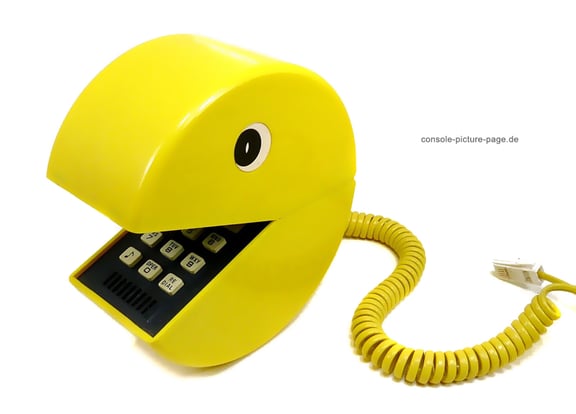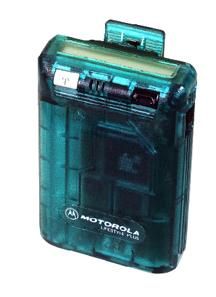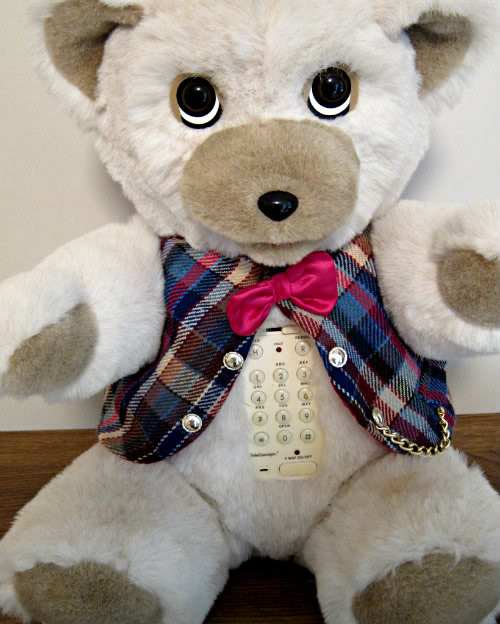If you’ve ever listened to an intro or an interlude on an En Vogue (or really, any ‘90s R&B girl...
Playing Telephone
.jpeg?width=960&height=600&name=payphone%20(1).jpeg) Have you called the operator lately? Like, if you dial “0,” is there still someone there to direct your call?
Have you called the operator lately? Like, if you dial “0,” is there still someone there to direct your call?
As a kid, I used the operator like an early form of Google. I would dial zero and ask for phone numbers of the friends I wanted to invite over to play or to see if I could find a listing for the mother of a girl I used to play with at the old apartment I’d lived in with my mom years before. There was a payphone outside of the gymnasium of my elementary school where I would call the operator and task her with these requests. This payphone was a regular source of amusement for my friends and me. At school recess, we’d dial 1-800-HOT-BABE and crowd around the receiver to giggle about the raspy voice trying to entice us to pay $4.95 a minute for some hot phone action. It was extra fun when we could convince a boy to come over and listen and watch him blush and run away embarrassed.
The fact that they (you know, the phone booth people) just let a phone book hang from the vestibule always seemed like a great opportunity for mischief, too. Some people thought it was great fun to steal them, but that seemed a little labor intensive for something that was delivered right to my door. If someone hadn’t already swiped phone booth directory, I took great satisfaction in leaving my mark. Whether it was by drawing a heart around the number of a boy I liked or scrawling some anonymous message among the pages, I was quite the public nuisance if you needed to find a telephone listing in the Los Gatos, California area between 1990 and 1993.
Though there were a variety of free phone booth activities to enjoy in the early ‘90s, you could actually make a call from one for only a dime. If someone had spare change, we’d use the directory to pick random phone numbers to prank call. If I brought my Walkman, I’d call the radio station to request songs in the hopes the D.J. would drop everything to play it so I could hear it before the end of recess. This literally NEVER worked out. I wasted so many dimes requesting Marky Mark, P.M. Dawn, and Spin Doctors only to return to class before my song played, hopefully, preceded by playback of my tiny child voice calling in the request (but probably not).
Basically, if there was a phone available, I was never bored. And the older I got, the more I wanted to talk.
A PHONE TO CALL MY OWN
I got the first phone of my very own when I was only seven or eight. It was a teddy bear speakerphone! He had a dial pad on his chest, and his eyes and mouth moved when the caller was talking to you. He was a good starter phone, but eventually, I wanted more privacy. Maybe one of those clear plastic phones that let you see the inner workings of the magical technology that allowed me to never shut up. I imagined myself as that typical valley girl, talking for hours, phone cord wrapped through my fingers, laying on my stomach, feet crossed in the air, or sprawled on my back, head hanging upside down off the bed. Yes, I really posed myself this way, and I can tell you that, in reality, this was very uncomfortable.
I never did get that clear phone, but I did select some other stylish phones. First was a Pac-Man phone that I think my parents had received as a gag gift but I happily adopted when I was in middle school. After that, I got a very ‘90s-mod flat black phone with little teal buttons and a thin, sleek receiver. At some point, I modified it with letter stickers that spelled “bitch.” When my family finally upgraded to a cordless phone, it had that feature that allowed you to locate the handset from the base, but it was never necessary. It was always in my room.

I was only a matter of time until I started begging my parents for call waiting. I tried to sell them on the benefit of never missing a call while I babbled endlessly to friends and boys—most of whom I’d seen hours before at school. “You’ll never have to miss a call again,” I’d reason with them. Oh, except for when I was using this feature for the real benefit I was after.
PARTY LINE
Party-line (three-way calling if you’re nasty) allowed the user to switch over to the other line, to make a call and join another party into the call. My friends and I mastered the art of the conference call when they only thing we needed to conference about was which boys we could “go with” because one of the others was done crushing on him. One person with party line would call one who didn’t and another person who did. After the first three were connected the other person with party line would add a fourth, and so on. I think once, we had a six-way. Wild times, they were.
The other benefit of the call waiting/three-way calling feature was the ability to get calls long past a socially acceptable hour. I learned from friends that if you wanted to talk on the phone all night instead of sleep, you would agree upon a time, and one person would call POP-CORN and listen to date and time information (or 1-800-HOT-BABE) and listen to the prerecorded message and wait for the other person to beep in on the other line. You could switch calls and parents were none the wiser. If you could keep the conversation to a whisper, you were free to talk all night. I needed this.
PRIVATE PHONE LINE
Once the parents realized that the people calling for them would, in fact, get a busy signal when you were using the call waiting feature to talk to two people at once, the next obvious solution was to get a separate phone line installed directly in your bedroom. I desperately wanted my very own phone number. I mean, D.J. Tanner from Full House had her own line, why couldn’t I? I could give out my number to friends and boys and never worry about my dad answering and telling someone I couldn’t come to the phone because I was in the bathroom.
Sadly, this was a dream that would never be realized. I had to go on sharing a phone number with my parents, but I got to put my own personal touch on the family answering machine. With Vanilla Ice as my muse, I composed the following dope rhyme:
Don’t hang up, just wait / You’ve reached 353-4268 / This is the Veltrop residence/ but we’re not here in the present tense/ So leave a message at the tone / and we’ll get back to you when we get home. / Yep! Yep!
REACH OUT AND TOUCH SOMEONE (CALLING CARDS)
When my family moved to Idaho, my grandparents starting sending me long distance calling cards so I could call them without running up my parents’ long distance bill. I used these cards for their intended purpose, and maybe to make a few other calls to the friends in California I missed so much. By middle school, though, I discovered there was a calling card plan that was refillable and would allow me to make calls from payphones to request rides. I thought this would be a vast improvement from my usual tactic of placing a collect call under the name of “I-missed-the-bus-please-come-pick-me-up-I’m-in-front-of-the school!” Plus they looked like a credit card and I longed for the feeling of maturity I was sure would come from whipping out my calling card rather than digging for change at the bottom of my backpack.
BEEP ME!
You know what complements a calling card perfectly? A pager. Anytime someone needed me, they could page me, I’d get to the closest pay phone and use my calling card to get back to them as soon as possible. And why wouldn’t my parents want to finance this whole operation? Even in junior high school, I was a very important person, and I didn’t want anyone to miss the opportunity to get ahold of me. Even my parents.
Staying connected was important, but if I'm honest, much of the allure of the pager was as a fashion accessory. It said I’m tech savvy, important, a little bit rich and maybe even a drug dealer.

I spent months becoming fluent in pager code. Many of my friends had pagers and I sent them intricate numeric messages that took several minutes to compose, all so they wouldn’t have to find a phone to listen to a voice message. Pager code was also handy for analog purposes. When I spent class periods tuning out the lesson and, instead, writing notes to pass to friends between classes, I could encrypt my more incriminating communications into page code.
I spent years fantasizing about decorating my very own Motorola Bravo with stickers and nail polish. But by the time I actually got my own pager in 1999, I was a junior in high school, it was some off-brand model in a champagne color (because I’ve always been classy AF), and most of my beeps were from coworkers to see if I could cover their shift or from my parents asking if I could pick my younger siblings up from daycare so they could work late. At least, by this point, it was much easier to listen to my messages and return the calls from my friends’ cell phones.
CELL PHONE KILLED THE CONVERSATION
I ended up having to wait until after I turned 18 to get my first cell phone. I hit the Sprint Store on my lunch break at the mall. In a matter of 20 minutes, I had a blue candybar phone with an antenna that still didn’t get reception at my mom’s house where I still lived. This phone gave me the last four digits that would be my PINs and garage codes until I gave it out to too many people, but I still have a phone number with those last four digits today.
However, my relationship with phones has changed drastically since that first liberating day of phone-ownership. I’m unsure if it’s the advances in technology, maturity, or responsibility that have made me wary of the device. I would rather use my phone to text plans to meet up and talk in real life than sprawled out on my bed talking on the phone for hours. I prefer to spend my alone time enjoying the quiet aloneness than filling my earholes with the chatter of others. But I can’t remember the last time I powered down my phone.
Somewhere along the way, the telephone went from being a symbol of independence to something I long for the willingness to turn off and experience freedom.
I wish my iPhone X gave me the same thrill my KC Bearifone did.



+(1).jpeg?height=200&name=shutterstock_1558086209+(1)+(1).jpeg)
